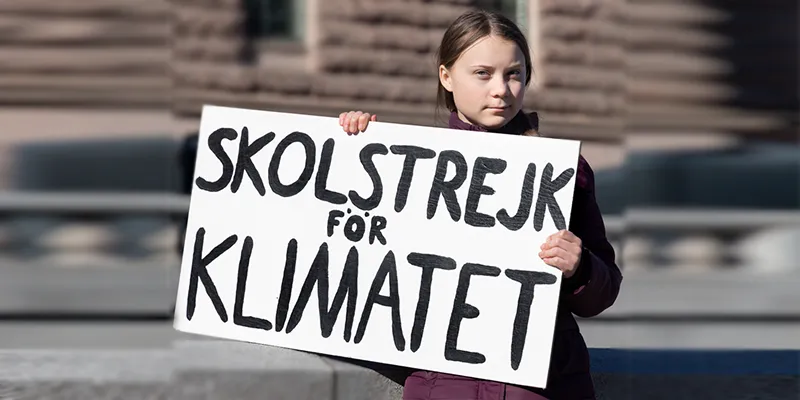World Environment Day: How 16-year-old activist Greta Thunberg is inspiring Bengaluru’s youth to fight against climate change
On May 24, hundreds of young activists gathered at Bengaluru’s Town Hall to speak against and demand action on climate change. We talk to some of these youngsters to know the changes they are aiming for.
On August 20, 2018, Swedish student Greta Thunberg sat outside the Parliament in Stockholm, with a hand-painted sign that said 'Skolstrejk för Klimatet' (School strike for Climate). She sat there alone, from 8.30am to 3pm - the duration of an entire school day. As the weeks went by, more people began joining in. The movement quickly went viral on social media, and students around the world began protesting outside their own government establishments.

Greta Thunberg in Stockholm, Sweden
Soon after this, in October, the UN Intergovernmental Panel on Climate Change (IPCC) released a report that said that we have only 12 years to make changes to global energy infrastructure, on an unprecedented scale so that global warming can be limited to moderate levels.
In less than a year, Greta has spoken out about climate change at various high-level platforms, including the United Nations, and started a global movement, Fridays for Future.
The movement comprises young people fighting for a better future, of whom many regularly participate in the climate strike every Friday.
On March 18 this year, over a million students participated in the first Global Climate Strike, urging governments and citizens to act on the effects of the rapidly changing climate.
The second Global Climate Strike took place on May 24, and was organised in various cities across India, including Bengaluru. Hundreds of students and young activists gathered for a peaceful protest at Town Hall where they held up banners and signs, gave speeches, performed music, depicted climate change through street plays, and chanted slogans like “What do we want? Climate justice! When do we want it? Now!”

Protesters hold up signage at the Global Climate Strike in Bengaluru
SocialStory spoke to a few attendees to understand why young people uniting to fight for a cleaner, greener tomorrow is important, and what changes they want to see.
Young voices matter
"Greta, a 16-year-old girl, is urging politicians to acknowledge how much they have messed up by putting the climate issue on the backburner for this long, and making the whole world realise the dire state of the climate emergency. She inspires me because she is doing what I always wanted to do, on a much larger scale, while still acknowledging and valuing her place as a student who just wants to learn," said Sriranjini Raman, 19, who is a Development and Environment Resources student.
Sriranjini pointed out that despite the young population making up over half the global population, they aren't included in local or global decision-making processes.
"Our generation is growing up with the climate crisis and we need to deal with it for the rest of our lives. We will not be the voiceless future of humanity," she added.

Sriranjini Raman addressing the protesters
Garden city no more
“Previously, Bengaluru was heralded as the ‘garden city of India,’ but now, more people are beginning to identify it as the city with bad traffic and lakes that catch fire. Climate change is not portrayed as the alarming issue that it really is, so the climate strike is to draw attention to this crisis,” said Aabharana, a 19-year-old who studies law.
On what she expects from the government, Aabharana said that one of the major concerns is the public transport system. This year, the vehicle population in Bengaluru crossed a worrying number of 80 lakh, which calls for serious improvements in the city’s metro and bus networks.
Intolerable pollution
The rubbish on the sides of the roads, smoke in the air, and honking vehicles have become a regular sight for city-dwellers. It’s almost impossible to walk outside without stepping over garbage, or making way for vehicles climbing on to footpaths. Solving this no easy task, but it can’t be done single-handedly.
“We need to live freely, breathe fresh air and have clean water, but just depending on the government won’t bring about a change. I want to let people know that they too can help out by simply working together as a community, and doing small things like picking up rubbish and disposing of it correctly,” said Aditya, a volunteer with various non-profit organisations.

A street play depicting the effects of climate change
A sustainable future for our children
When people with the power to influence others endorse movements like the one against climate change, the masses are more likely to pay attention. Kannada film actor Ramachandra Raju made a special appearance at the protest and addressed the crowd:
“Parents always think about giving their children a good education and saving money for their future. But they need to start focusing on saving our environment, because it’s unfair for them to exploit their share of what nature has to offer and leave their children with nothing. It is great that young people have united to conduct this protest for such an important cause, and I hope the movement keeps growing.”

Actor Ramachandra Raju speaking to the gathering
This is not a drill
Karen Raymond, the Indian ambassador of the Fridays for Future movement said,
“We must get the newly formed government to declare a climate emergency. The heat, water crisis, air pollution, deforestation, and high carbon footprint are weighing us all down, and we need to make a change.”
“Another serious issue that many don’t discuss, is the population. By 2022, India is projected to overtake the population of China, which is more than 1.4 billion people. Just imagining the demand for resources at that scale really scares me,” she added.
Karen also pointed out that animal agriculture is another huge contributor to the water crisis and pollution. According to the UN Food and Agriculture Organisation (FAO), global demand for livestock products is projected to increase by 70 percent to feed a population of nearly 10 billion in the year 2050.
Although the resources needed to sustain animal agriculture are already being threatened by climate change, most governments brush the subject under the rug. The meat industry brings in huge amounts of income; in FY 2016-17, India alone exported nearly 11 lakh tonnes of meat worth Rs 22,074 crore. The industry may be profitable, but is proving to be detrimental to the environment in the long term.

Artists painting while the protest takes place
The takeaway
As the protest continued for over two hours, the weather frequently fluctuated between rain and shine, while traffic built up steadily. Protesters yelled slogans and waved their banners around, hoping that onlookers’ interest in the climate crisis would not stop at taking photographs.
Although we have a designated World Environment Day, leading an environmentally-conscious lifestyle, so that the planet is saved from its premature doom, should be our top priority. We must do our bit in any way possible; be it using less plastic, deviating from fast fashion, or using more public transport.
The sooner that governments and corporates join in to make serious changes in policy, the more secure our planet will be for future generations.
Greta Thunberg nails it when she says:
“Adults keep saying we owe it to the young people to give them hope. But I don't want your hope; I don't want you to be hopeful. I want you to panic, I want you to feel the fear I feel every day. And then I want you to act, I want you to act as if you would in a crisis. I want you to act as if the house was on fire, because it is.”









